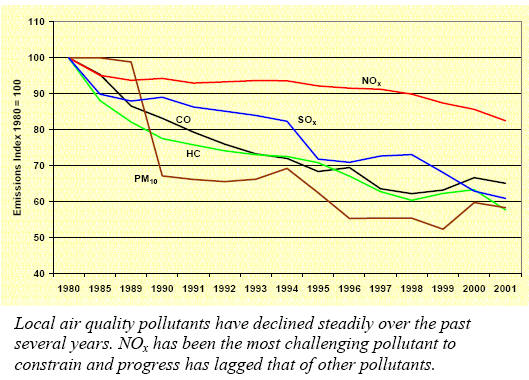
 |
NEWSROOM |
|
|
|
||||
|
How Do Aviation Emissions Compare To General Trends In Local Air Pollutants? |
||||
 |
Compared to other sources, aviation emissions are a relatively small contributor to air quality concerns both with regard to local air quality and greenhouse gas emissions. While small, however, aviation emissions cannot be ignored. In the past three decades, aggregate emissions of the air pollutants EPA regulates (nitrogen dioxide, ozone, sulfur dioxide, particulate matter, carbon monoxide, and lead) have declined by 25 percent nationally, according to their report National Air Quality 2001 Status and Trends10. As can be seen in the following chart, greater progress has been made with some individual pollutants than with others. Aircraft emissions have also declined over time when you consider the emissions from transporting one passenger one mile. The following chart shows that relative aircraft emissions have fallen consistently over time. |
|||
|
Total aircraft emissions have increased, however, since aviation has grown considerably over the same period. As with emissions nationally, a great deal of progress has been made reducing emissions of HC and CO. NOx, a key constituent of ozone, has proven to be the most difficult pollutant to control both nationally and for aviation. NOx comes from a wide variety of sources in all sectors of the economy. Since essentially all NOx comes from combustion processes, electric utilities, industry, and transportation are significant emitters and make up the largest share of the total inventory. Currently aviation contributes 0.4 percent of the inventory as can be seen in the illustration. Aviation’s contribution to the national NOx emissions inventory has recently declined further as air travel growth has been interrupted during the past two to three years due to the terrorist acts of 9/11, the war on terrorism in Iraq, the emergence of severe acute respiratory syndrome (SARS), and a generally difficult economic environment. These conditions have caused a more than ten- percent decline in air traffic and a similar drop in emissions. |
||||
While it is apparent from this data that aviation emissions make only a small contribution to regional emissions, even at the largest airports and even in areas with the worst air quality, it is still a contribution that needs to be dealt with effectively.
|
|||||||||
|
|||||||||
| ©AvStop Online Magazine Contact Us Return To News | |||||||||